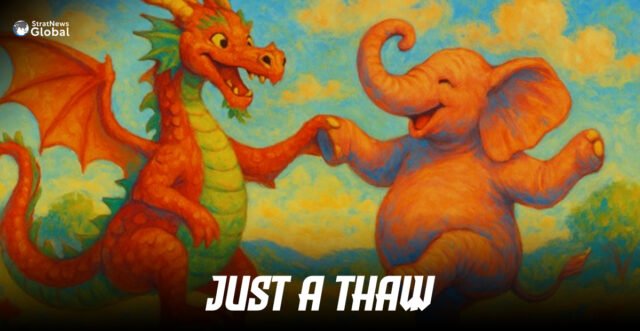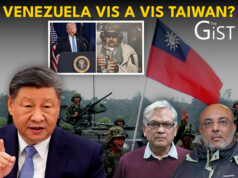India’s recent move to resume issuing tourist visas to Chinese nationals has triggered a fresh wave of commentary about a potential thaw in bilateral ties.
Diplomatic metaphors abound—the Elephant and the Dragon may now be ready to tango, waltz, or bhangra, depending on who you ask.
Amid all the renewed optimism, it might be worth revisiting a 2024 paper by the Takshashila Institution which reminds us of the hard realities beneath the rhetoric. Titled Contours of a New Modus Vivendi with China and authored by Manoj Kewalramani, the report acknowledges the signs of dialogue but warns against mistaking them for structural change.
“Let’s not get carried away by the headlines,” says Kewalramani. “The challenges in this relationship are deep and difficult to navigate.”
Framed around three fundamental questions—what India wants from its relationship with China, what a stable equilibrium might look like, and what it would take to get there—the paper offers six clear recommendations grounded in strategic realism and national power, not sentiment.
Kewalramani argues that volatility in the India-China relationship is structural and unlikely to dissipate anytime soon. It stems from three interlocking dynamics: the simultaneous rise of both powers and the resulting friction over overlapping spheres of interest; a persistent and widening power asymmetry in China’s favour, with its GDP over five times India’s and a defence budget roughly triple; and a shifting global order marked by US-China rivalry, where India is seen by both sides as a critical swing state.
While Beijing seeks to constrain Indian options, including through coercive diplomacy and military pressure along the LAC, New Delhi has responded with a mix of internal balancing and external alignment, deepening ties with the US, France, Japan and Australia while preserving its strategic autonomy.
Rather than proposing a reset or grand reconciliation, the report recommends a set of carefully calibrated steps to stabilise the relationship on India’s terms.
These include closing the power gap through sustained economic growth and investment in infrastructure, defence, technology and education; refusing to accept the altered ground reality in Eastern Ladakh and restoring lost patrolling rights; and restoring structured political dialogue, not for optics but to clarify red lines and enable pragmatic management of friction.
Kewalramani also advocates for a shift from calls for decoupling to a strategy of de-risking: creating a formal investment review mechanism, maintaining openness to Chinese capital and inputs where they support Indian industrial goals, while cordoning off critical sectors to prevent strategic leverage.
Equally important, he argues, is the need to preserve people-to-people and institutional exchanges—not as a gesture of goodwill, but to prevent dangerous misperceptions and to deepen India’s own understanding of Chinese society and politics.
He warns that India must not allow Beijing to exercise a veto over its foreign partnerships. Strengthening ties with the US and other Indo-Pacific actors must continue, not as part of an anti-China front, but as a reflection of Indian interests and agency.
The report also cautions against misreading China’s recent rhetorical softening. Language around “mutual respect” and “coexistence” may sound conciliatory, but without tangible policy shifts, particularly on the border and in multilateral forums, they amount to little more than a change in tone.
Since 2023, Chinese diplomats have dialled down the Wolf Warrior rhetoric and engaged in more restrained outreach. But as Kewalramani notes, this stylistic shift should not be confused with a strategic rethink. China’s posture remains hierarchical, adversarial, and fundamentally resistant to Indian aspirations for parity.
His central message is blunt: India must not approach China through nostalgia, slogans, or summitry. It must do so through national strength, strategic discipline, and institutional capacity.
In a career spanning three decades and counting, Ramananda (Ram to his friends) has been the foreign editor of The Telegraph, Outlook Magazine and the New Indian Express. He helped set up rediff.com’s editorial operations in San Jose and New York, helmed sify.com, and was the founder editor of India.com.
His work has featured in national and international publications like the Al Jazeera Centre for Studies, Global Times and Ashahi Shimbun. But his one constant over all these years, he says, has been the attempt to understand rising India’s place in the world.
He can rustle up a mean salad, his oil-less pepper chicken is to die for, and all it takes is some beer and rhythm and blues to rock his soul.
Talk to him about foreign and strategic affairs, media, South Asia, China, and of course India.





